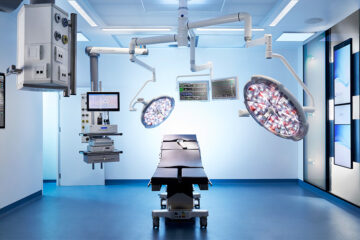Operating room lights play a crucial role in surgical procedures, providing surgeons with optimal visibility and ensuring the safety and success of surgical interventions. With advances in technology, modern operating room lights offer improved illumination, flexibility, and efficiency, enhancing surgical outcomes and patient safety. In this comprehensive guide, we will explore the latest advances in operating room lights, including types of lights, key features, and considerations for choosing the right lighting system for surgical facilities.
Importance of Operating Room Lights
Operating room lights are essential for providing surgeons with the illumination they need to perform surgical procedures safely and effectively. Proper lighting in the operating room is critical for:
- Optimal Visibility: Good lighting allows surgeons to see the surgical field clearly, identify anatomical structures, and perform precise surgical maneuvers.
- Reduced Eye Strain: Bright, uniform lighting reduces eye strain and fatigue for surgical staff, helping them maintain focus and concentration during lengthy procedures.
- Improved Patient Safety: Adequate lighting ensures that surgical teams can accurately assess the patient’s condition, monitor vital signs, and detect any complications that may arise during surgery.
- Enhanced Sterile Environment: Operating room lights are designed to minimize shadows, glare, and heat generation, creating a sterile and comfortable environment for surgical procedures.
Types of Operating Room Lights
There are several types of operating room lights available, each offering unique features and benefits:
1. Ceiling-Mounted Lights:
Ceiling-mounted lights are the most common type of operating room lights. These lights are mounted on the ceiling above the surgical table and can be adjusted and positioned as needed to provide optimal illumination of the surgical field.
2. Wall-Mounted Lights:
Wall-mounted lights are mounted on the walls of the operating room and provide additional lighting to complement ceiling-mounted lights. These lights can be adjusted and positioned to provide targeted illumination of specific areas within the surgical field.
3. Portable Lights:
Portable lights are lightweight, mobile lights that can be easily moved and positioned as needed. These lights are often used in emergency and trauma situations or in operating rooms where ceiling-mounted lights are not available.
Key Features of Modern Operating Room Lights
Modern operating room lights offer a range of advanced features designed to enhance visibility, flexibility, and efficiency:
1. LED Technology:
LED (light-emitting diode) technology has revolutionized operating room lighting, offering bright, white light with excellent color rendering and minimal heat generation. LED lights are energy-efficient, long-lasting, and environmentally friendly, making them the preferred choice for modern surgical facilities.
2. Adjustable Intensity and Color Temperature:
Modern operating room lights feature adjustable intensity and color temperature settings, allowing surgeons to customize the lighting to suit their preferences and the specific requirements of each surgical procedure. Variable intensity and color temperature settings help reduce eye strain and improve visibility during surgery.
3. Shadow Reduction Technology:
Operating room lights are designed to minimize shadows and provide uniform illumination of the surgical field. Advanced shadow reduction technology, such as multiple light sources and overlapping light patterns, helps eliminate shadows and improve visibility, particularly during complex procedures.
4. Sterilizable and Hygienic Design:
Operating room lights are designed to meet strict sterilization and hygiene standards. Modern lights feature smooth, sealed surfaces that are easy to clean and disinfect, reducing the risk of contamination and infection in the operating room.
5. Touch-Free Controls:
Many modern operating room lights feature touch-free controls, allowing surgeons to adjust the lighting settings without having to touch the light fixture. Touch-free controls help maintain a sterile environment in the operating room and reduce the risk of cross-contamination.
6. Integrated Camera and Video Systems:
Some operating room lights are equipped with integrated camera and video systems, allowing surgical teams to capture high-definition images and videos of the surgical field. Integrated camera systems can be used for documentation, teaching, and telemedicine purposes.
Considerations for Choosing Operating Room Lights
When choosing operating room lights for surgical facilities, several factors should be taken into consideration:
1. Surgical Specialty and Procedure Requirements:
Different surgical specialties and procedures may have specific lighting requirements. For example, neurosurgery and orthopedic surgery may require brighter, more focused lighting, while minimally invasive surgery may benefit from adjustable color temperature settings.
2. Room Size and Configuration:
Consider the size and configuration of the operating room when choosing lighting systems. Ceiling-mounted lights are ideal for larger operating rooms with high ceilings, while wall-mounted and portable lights may be more suitable for smaller or irregularly shaped rooms.
3. Energy Efficiency and Cost:
Consider the energy efficiency and operating costs of different lighting systems. LED lights are energy-efficient and have a longer lifespan than traditional incandescent or halogen lights, resulting in lower energy bills and reduced maintenance costs over time.
4. Compatibility with Existing Equipment:
Ensure that the operating room lights are compatible with existing equipment and infrastructure, such as surgical tables, booms, and ceiling supports. Compatibility issues can lead to installation delays and additional costs.
5. Manufacturer Reputation and Support:
Choose operating room lights from reputable manufacturers with a proven track record of quality and reliability. Look for manufacturers that offer comprehensive support, including installation, training, and ongoing maintenance services.
Conclusion
Modern operating room lights play a vital role in ensuring the success and safety of surgical procedures. With advanced features such as LED technology, adjustable intensity and color temperature settings, shadow reduction technology, and sterilizable design, modern operating room lights offer improved visibility, flexibility, and efficiency for surgical teams. By considering factors such as surgical specialty and procedure requirements, room size and configuration, energy efficiency and cost, compatibility with existing equipment, and manufacturer reputation and support, surgical facilities can choose the right operating room lights to brighten the future of surgery and enhance patient outcomes.


